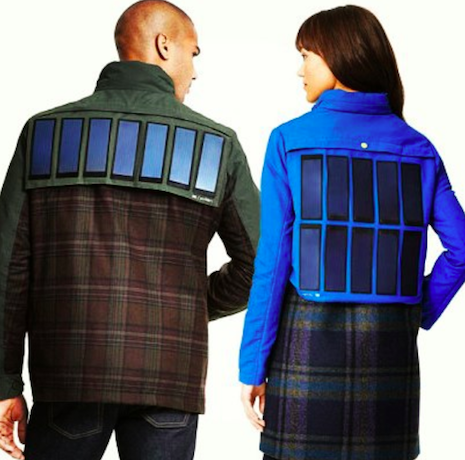 Emel and Aris makes coats with Loro Piana materials mixed with infrared heat. Image credit: Emel and Aris
Emel and Aris makes coats with Loro Piana materials mixed with infrared heat. Image credit: Emel and Aris
Fashion and technology are two seemingly disparate fields that are increasingly converging, leading to the creation of innovative garments that serve functional purposes.
According to Fashionbi’s “Innovation In Fashion-Tech Products” report, the Fourth Industrial Revolution is ushering in new technologies that can be applied to fashion design and production to meet consumer demand for connectivity. While tech-infused fashion has not yet seen widespread implementation, some early adopters show the potential of smart apparel and accessories.
"Opportunities are enormous, however, it seems that the luxury and fashion brands are still avoiding to invest in a launch of any smart item, apart from the smartwatches," said Yana Bushmeleva, chief operating officer at Fashionbi, Milan. "The majority of the innovations are coming from activewear brands or new startups."
Wearable fashion
The Fourth Industrial Revolution is centered on digitization, with advances such as 3D printing, machine learning and artificial intelligence impacting how both consumers and companies interact with the world around them. In the fashion industry, advances in fiber creation are making it possible to create smart garments.
One popular type of smart design is sensory wearables.
A number of brands have incorporated the idea of a fitness tracker into apparel. From a Victoria’s Secret sports bra with heart rate monitor to Nadi x Yoga pants that use vibrations to adjust the wearer’s form, fashion tech aimed at improving or recording performance fits into consumers’ wellness aspirations.
Ralph Lauren’s Polo Tech Shirt has biometric sensors woven into the fabric, allowing the wearer to measure heartbeat, respiration, stress level and energy output. The data is stored in a “black box” that transmits to an application on the wearer’s phone.
Introducing: The Polo Tech Shirt
Other sensing garments provide solutions outside of fitness.
Likeaglove leggings take a wearer’s measurements, helping them to find the right size as they are shopping online.
Meanwhile, Emel and Aris’ Smart Coat turns a lightweight fabric into toasty outerwear with the addition of adjustable infrared heat delivered via polymers. Constructed out of Loro Piana fabrics treated with its Storm System, the water- and wind-resistant coats are designed to be worn in all seasons.
The Smart Coat runs on a rechargeable battery that also enables wearers to charge a phone on-the-go.
Also meeting consumers’ desires to always be connected via mobile, Levi’s created a bicycle commuter-friendly coat that integrates phone data into a sleeve, allowing riders to interact with various apps without having to pull out their device. This design uses Google’s Jacquard yarn, which incorporates metal alloys into other fibers.
A number of brands have also developed apparel and accessories that provide conduction, allowing wearers to charge devices.
Both Tommy Hilfiger and Pauline Van Dongen have created garments with built-in solar panels, allowing consumers to charge their phone using energy captured from the sun.
 Tommy Hilfiger's solar powered coat. Image credit: Tommy Hilfiger
"I believe that the customers are not yet ready for some crazy and futuristic designs," Ms. Bushmeleva said. "The key to market could be in a combination of the traditional approach towards design but with the integrated technology which can solve day-to-day problems.
"And of course, such smart products should be reliable and safe, so the customer won't worry about the negative impact on health and skin or about the washing and cleaning of such garment."
Luxury lifestyle
While many of the connected creations out today come from more mass players, high-fashion has also played with incorporating tech in their designs.
Ralph Lauren fused together fashion and technology with the introduction of its Ricky Bag with Light.
Ralph Lauren describes the handbag as the “epitome of functional glamour, combining modern technology innovation with the enduring artistry of [the brand’s] signature silhouette.” The $5,000 bag features LED lights and a built-in USB charger and discrete rechargeable battery (see story).
Ricky Bag with Light
For the 2016 Metropolitan Museum of Art Costume Institute Gala, some designers took the theme “Manus x Machina: Fashion in an Age of Technology” to a new level.
Marchesa teamed with IBM to create a smart dress for model Karolina Kurkova, which featured LEDs that changed color based on the reaction from consumers on social media. Meanwhile, Zac Posen embraced a new textile for his gown for actress Claire Danes, crafting the red carpet look out of fiber-optic fabric that glowed in the dark.
Tommy Hilfiger's solar powered coat. Image credit: Tommy Hilfiger
"I believe that the customers are not yet ready for some crazy and futuristic designs," Ms. Bushmeleva said. "The key to market could be in a combination of the traditional approach towards design but with the integrated technology which can solve day-to-day problems.
"And of course, such smart products should be reliable and safe, so the customer won't worry about the negative impact on health and skin or about the washing and cleaning of such garment."
Luxury lifestyle
While many of the connected creations out today come from more mass players, high-fashion has also played with incorporating tech in their designs.
Ralph Lauren fused together fashion and technology with the introduction of its Ricky Bag with Light.
Ralph Lauren describes the handbag as the “epitome of functional glamour, combining modern technology innovation with the enduring artistry of [the brand’s] signature silhouette.” The $5,000 bag features LED lights and a built-in USB charger and discrete rechargeable battery (see story).
Ricky Bag with Light
For the 2016 Metropolitan Museum of Art Costume Institute Gala, some designers took the theme “Manus x Machina: Fashion in an Age of Technology” to a new level.
Marchesa teamed with IBM to create a smart dress for model Karolina Kurkova, which featured LEDs that changed color based on the reaction from consumers on social media. Meanwhile, Zac Posen embraced a new textile for his gown for actress Claire Danes, crafting the red carpet look out of fiber-optic fabric that glowed in the dark.
 Claire Danes at the 2016 Met Gala. Image credit: Zac Posen
Product design is just one aspect of the fashion industry that is poised for disruption.
"Currently, we are working on a new research about the relationship between tech and fashion industries, and we saw that every step in a fashion process starting from the raw materials to the delivery of the final product can be automatized," Ms. Bushmeleva said.
"The technology already entered fashion industry and in the following years the synergy between these two fields will be even stronger," she said. "There are already case-studies about e-textiles, innovative ideas for the product design and its production, stores without staff and the delivery of the goods from the ecommerce sites by robots."
Claire Danes at the 2016 Met Gala. Image credit: Zac Posen
Product design is just one aspect of the fashion industry that is poised for disruption.
"Currently, we are working on a new research about the relationship between tech and fashion industries, and we saw that every step in a fashion process starting from the raw materials to the delivery of the final product can be automatized," Ms. Bushmeleva said.
"The technology already entered fashion industry and in the following years the synergy between these two fields will be even stronger," she said. "There are already case-studies about e-textiles, innovative ideas for the product design and its production, stores without staff and the delivery of the goods from the ecommerce sites by robots."
